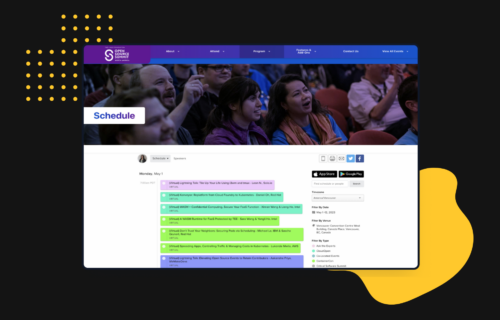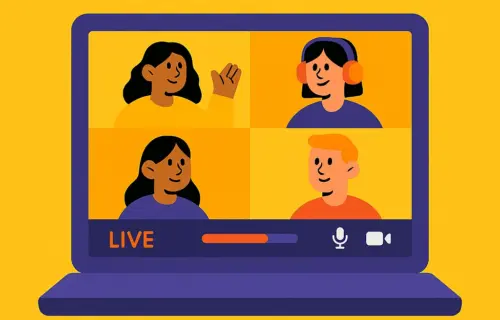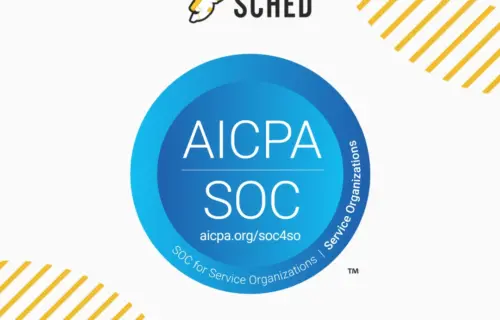Key Takeaways:
Table of contents
- 1 Key Takeaways:
- 2 Why Long Lines Happen at School Events
- 3 How Long Lines Affect Your School Event Experience
- 4 How to Prevent Check-In Delays Without Adding More Work
- 5 Start Your Event Smoothly With Sched’s Event Management Platform
- 6 Frequently Asked Questions
- 6.1 What causes long lines at school event check-in?
- 6.2 How can long lines affect parent and student participation?
- 6.3 What are simple ways to speed up check-in without extra staff?
- 6.4 How do long lines impact fundraising at school events?
- 6.5 Why is it important to plan check-in as part of the event experience?
- 6.6
- Long lines frustrate families and staff even before your event begins, weakening the connection you worked hard to build.
- Common causes include pre-event communication that’s unclear, paper sign-ins, and disconnected tools.
- Simple steps like pre-registration, mobile schedules, self check-in, and better communication through a single event platform can prevent bottlenecks.
- When logistics run smoothly, your team can focus on what matters: creating meaningful experiences at your event.
It’s parent night, and families are lined up outside the gym. Some are bringing uneasy younger siblings. Others are checking their watches. Staff at the table are flipping through printouts, looking for names, and trying to hand out schedules. Before anyone has walked into a session, they’re already worn out.
When check-in is slow or confusing, the event starts on the wrong foot: families are frustrated, staff feel stressed, and the chance to connect is harder to get back.
Why Long Lines Happen at School Events
Long lines aren’t just bad luck. They usually happen when:
- Your team relies on paper sign-ins, spreadsheets, or printouts that take time to check.
- Registration info lives in one tool, schedules in another, and nothing connects.
- Families didn’t get clear instructions ahead of time, so they’re unsure what to do at the door.
How Long Lines Affect Your School Event Experience
Beyond delays, waiting lines make you lose what you worked so hard to achieve. Here are some common results:
Frustrated attendees
Families and students don’t come to your event to stand in line. When they’re stuck waiting, frustration sets in fast. That can mean complaints, early exits, or negative feedback on social media, all of which hurt your school’s connection with the community.
Example: A 10-minute wait at a school carnival might make families skip activities or leave early, lowering participation and revenue.
Time spent waiting instead of connecting
Every extra minute waiting is time taken away from what matters: connecting with teachers, supporting fundraisers, or enjoying performances. Long lines also pull staff and volunteers away from other jobs as they try to manage the crowd.
Example: If 100 parents wait an extra 15 minutes to check in for conferences, that’s 25 hours of time lost. That time could have gone to meaningful conversations.
Missed chances to raise funds
If your event raises funds, long lines can cost you money. Families are less likely to buy food, tickets, or raffle entries if they’re frustrated or running short on time.
Extra work for your team
Bottlenecks at check-in put pressure on your team, delay your schedule, and sometimes force last-minute fixes like assigning extra staff to the gates when they were needed elsewhere.
Safety risks
Crowded lines can create safety concerns, especially at large events or in extreme weather. Tripping hazards, pushing, or overheating can all put attendees at risk.
Fewer attendees come back next time
When an event starts with confusion or long waits, it leaves a lasting impression. Families may think twice before attending the next one, especially if they have young kids, tight schedules, or had to leave early the first time.
Lost chances to build community
Perhaps the biggest cost: long lines take away from what the event was supposed to be about. Parents lost key info, students miss their moment, and the community connection you worked so hard to build weakens.
Example: A parent who leaves back-to-school night early because of check-in delays misses out on learning about programs that could benefit their child.
How to Prevent Check-In Delays Without Adding More Work
Imagine a parent night where lines are a distant memory, and your team feels calm and in control. You don’t need more staff or hours to do it. What helps most to prevent lines is:
- Clear pre-event communication. Share event details, including arrival tips and parking info to make sure attendees know where to go, what to expect, and when to arrive.
- Online pre-registration. Have customizable sign-up forms so you’re not filling information last minute.
- Mobile-friendly schedules in an event app. Give people access to their agendas before they walk in.
- Dispersed arrival times. If the event allows, assign specific time slots for different activities to spread out attendance.
- Self check-in or QR code scanning. Let people sign themselves in quickly to avoid bottlenecks at the door.
- Multiple entry points. Open several entrances to the venue, clearly marked with signs, to split the crowd.
- Real-time visibility with an attendance tracking tool. Know who’s already checked in, who’s missing, or where they are at the moment.
Having all these available in a single platform means staff can focus on the event itself, and not on managing logistics.
Consider the challenge faced by Belton ISD in Texas. With over 2K attendees at their professional learning events, managing check-ins was a monumental task. They needed a way for participants to move smoothly, without long lines or administrative headaches.
That’s where a unified system made all the difference. As Vickie Dean, Director of Professional Learning at Belton ISD, shared: “people checked themselves in for each of the sessions,” saving them the lines and the administrative work in an event with over 2,000 attendees.
Before you start planning your next event, ask yourself questions such as:
- How long does check-in take at our events now?
- Are participants clear on where to go when they arrive?
- Do we have one system that handles check-in, updates, and schedules?
Start Your Event Smoothly With Sched’s Event Management Platform
When you fix check-in, you set the tone for everything that follows. Participants feel welcomed, staff feel confident, and attendees can focus on what they came for, without frustration.
Sched helps schools with events of all sizes deliver a smooth experience at check-ins, with an intuitive platform that doesn’t require IT support.
Are you ready to create better events from the first check-in? Try Sched for free.
Frequently Asked Questions
What causes long lines at school event check-in?
Long lines often happen when check-in depends on paper lists, spreadsheets, or tools that don’t connect with your schedules or registrations. Without a single system, it takes staff longer to process each person, leading to delays.
How can long lines affect parent and student participation?
Long waits at check-in can discourage families from staying for the full event. Some may skip activities, leave early, or hesitate to attend the next event, especially if the experience felt disorganized.
What are simple ways to speed up check-in without extra staff?
Online pre-registration, clear pre-event instructions, mobile-friendly schedules, and self check-in options like QR codes help speed up entry. These approaches let schools handle check-in efficiently without needing more staff.
How do long lines impact fundraising at school events?
When families spend time in line, they have less time (and patience) for things like food sales, raffles, or other fundraising activities. That can reduce the overall success of the event’s goals.
Why is it important to plan check-in as part of the event experience?
Check-in sets the tone for the entire event. A smooth, welcoming entry helps families feel confident and engaged from the start, while long waits create frustration that’s hard to undo.








